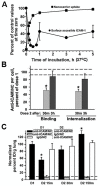Alterations in Cellular Processes Involving Vesicular Trafficking and Implications in Drug Delivery
- PMID: 31105241
- PMCID: PMC6352689
- DOI: 10.3390/biomimetics3030019
Alterations in Cellular Processes Involving Vesicular Trafficking and Implications in Drug Delivery
Abstract
Endocytosis and vesicular trafficking are cellular processes that regulate numerous functions required to sustain life. From a translational perspective, they offer avenues to improve the access of therapeutic drugs across cellular barriers that separate body compartments and into diseased cells. However, the fact that many factors have the potential to alter these routes, impacting our ability to effectively exploit them, is often overlooked. Altered vesicular transport may arise from the molecular defects underlying the pathological syndrome which we aim to treat, the activity of the drugs being used, or side effects derived from the drug carriers employed. In addition, most cellular models currently available do not properly reflect key physiological parameters of the biological environment in the body, hindering translational progress. This article offers a critical overview of these topics, discussing current achievements, limitations and future perspectives on the use of vesicular transport for drug delivery applications.
Keywords: cellular vesicles; disease effects on vesicular trafficking; drug delivery systems and nanomedicines; drug effects on vesicular trafficking; fission and intracellular trafficking; role of the biological environment; transcytosis and endocytosis of drugs carriers; vesicle fusion.
Conflict of interest statement
The author declares no conflict of interest.
Figures






Similar articles
-
Vesicular Transport Machinery in Brain Endothelial Cells: What We Know and What We Do not.Curr Pharm Des. 2020;26(13):1405-1416. doi: 10.2174/1381612826666200212113421. Curr Pharm Des. 2020. PMID: 32048959 Review.
-
Research progress on vesicular trafficking in amyotrophic lateral sclerosis.Zhejiang Da Xue Xue Bao Yi Xue Ban. 2022 Jun 25;51(3):380-387. doi: 10.3724/zdxbyxb-2022-0024. Zhejiang Da Xue Xue Bao Yi Xue Ban. 2022. PMID: 36161717 Free PMC article. Review. English.
-
Spatial proteomics of vesicular trafficking: coupling mass spectrometry and imaging approaches in membrane biology.Plant Biotechnol J. 2023 Feb;21(2):250-269. doi: 10.1111/pbi.13929. Epub 2022 Nov 4. Plant Biotechnol J. 2023. PMID: 36204821 Free PMC article. Review.
-
Recent advances in intestinal macromolecular drug delivery via receptor-mediated transport pathways.Pharm Res. 1998 Jun;15(6):826-34. doi: 10.1023/a:1011908128045. Pharm Res. 1998. PMID: 9647346 Review.
-
Transferrin Functionization Elevates Transcytosis of Nanogranules across Epithelium by Triggering Polarity-Associated Transport Flow and Positive Cellular Feedback Loop.ACS Nano. 2019 May 28;13(5):5058-5076. doi: 10.1021/acsnano.8b07231. Epub 2019 May 6. ACS Nano. 2019. PMID: 31034211
Cited by
-
New Cellular Models to Support Preclinical Studies on ICAM-1-Targeted Drug Delivery.J Drug Deliv Sci Technol. 2024 Nov;101(Pt A):106170. doi: 10.1016/j.jddst.2024.106170. Epub 2024 Sep 10. J Drug Deliv Sci Technol. 2024. PMID: 39669707
-
An Updated View of the Importance of Vesicular Trafficking and Transport and Their Role in Immune-Mediated Diseases: Potential Therapeutic Interventions.Membranes (Basel). 2022 May 25;12(6):552. doi: 10.3390/membranes12060552. Membranes (Basel). 2022. PMID: 35736259 Free PMC article. Review.
-
Enhanced drug delivery to cancer cells through a pH-sensitive polycarbonate platform.Biomater Sci. 2023 Jan 31;11(3):908-915. doi: 10.1039/d2bm01626e. Biomater Sci. 2023. PMID: 36533676 Free PMC article.
-
Polymer-based drug delivery systems under investigation for enzyme replacement and other therapies of lysosomal storage disorders.Adv Drug Deliv Rev. 2023 Jun;197:114683. doi: 10.1016/j.addr.2022.114683. Epub 2023 Jan 16. Adv Drug Deliv Rev. 2023. PMID: 36657645 Free PMC article. Review.
-
Starvation insult induces the translocation of high mobility group box 1 to cytosolic compartments in glioma.Oncol Rep. 2023 Dec;50(6):216. doi: 10.3892/or.2023.8653. Epub 2023 Oct 27. Oncol Rep. 2023. PMID: 37888772 Free PMC article.
References
-
- Mather I.H. Biology and regulation of protein sorting and vesicular transport. In: Muro S., editor. Drug Delivery across Physiological Barriers. CRC Press; Boca Raton, FL, USA: 2016. pp. 65–96. Chapter 3.
Publication types
Grants and funding
LinkOut - more resources
Full Text Sources

